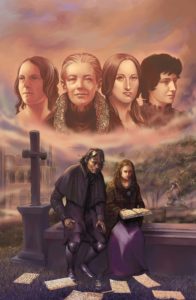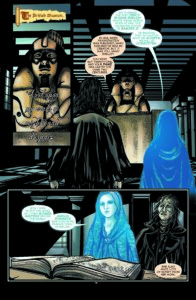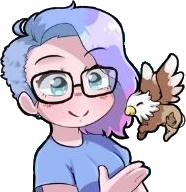When I first started to take my writing seriously, I went to see Ray Bradbury at a UCLA event. I loved Bradbury’s work, my favorite short story being “The Veldt.” You can imagine my dismay when he stood on that stage and announced that women could NOT write horror fiction. I remember sitting there and asking myself, “Did he just say that?”
Later, when I became a television writer, I heard the same sentiment, only now it included science fiction and edgy drama. This is why I ended up writing for Dr. Quinn, Medicine Woman; Touched by an Angel; and Murder, She Wrote (although I did get to write the vampire episode of the latter).
When I started my comic book company Kymera Press, I was told, “You can’t use all women artists. You have to have some men, or you’ll never sell your books.” That is why the company slogan is: We’re not asking for permission.
 Kymera Press does use all women artists and writers, and we don’t have a problem selling our books. One of our titles, Ivory Ghosts, is in the Smithsonian National Natural History Museum’s gift shop in Washington DC.
Kymera Press does use all women artists and writers, and we don’t have a problem selling our books. One of our titles, Ivory Ghosts, is in the Smithsonian National Natural History Museum’s gift shop in Washington DC.
I’ve been hearing women can’t for a long time. Though history has tried to hide it, women have been doing all kinds of things they’re not able to do. Hedy Lamarr, an actress during MGM’s golden age, co-invented a radio signaling device that changed radio frequencies to prevent the decoding of military messages. The system was a steppingstone to guaranteeing the security of communications and cellular phones.
You probably heard of Anne Easley, since the movie Hidden Figures was made about her and four other African American women who did significant work at NASA. Easley was considered a human computer in a time when there were no “machine” computers. When computers were born, she taught herself programming languages and worked as a programmer for NASA’s Centaur rocket project. This was the first technological stage for the space shuttle. Do you drive a hybrid car? Her work led the way to its development.
These are just two women who did what women supposedly couldn’t do. Women have been breaking barriers set for them for centuries. And this includes the field of writing.
Not convinced? When you think of Victorian writers, who comes to mind? Charles Dickens? Lewis Carroll? Bram Stoker? These men were famous in their time and ours. But what about Elizabeth Gaskell? Amelia Edwards? Margaret Strickland? These women were as renowned as the gentlemen above, but have you heard of them? An English major may answer yes, but the rest of us? Probably not.
 Nancy Holder is a contemporary horror writer who has won 5 Bram Stoker Awards for her horror fiction. I am the owner of Kymera Press, a comic book publisher. The two of us teamed up to resurrect the stories of these amazing women by adapting them into a comic book series entitled Mary Shelley Presents. Mary Shelley and Frankenstein’s monster introduce the stories of Elizabeth Gaskell (“The Old Nurse’s Story”), Edith Nesbit (“Man-size in Marble”), Margaret Strickland (“The Case of Sir Alister Moeran”) and Amelia Edwards (“Monsieur Maurice”). Nancy writes the adaptations and artists Amelia Woo, Dearbhla Kelly, and Saida Temofonte bring the comic books to life. The text of each original story is printed after the conclusion of the adaptation.
Nancy Holder is a contemporary horror writer who has won 5 Bram Stoker Awards for her horror fiction. I am the owner of Kymera Press, a comic book publisher. The two of us teamed up to resurrect the stories of these amazing women by adapting them into a comic book series entitled Mary Shelley Presents. Mary Shelley and Frankenstein’s monster introduce the stories of Elizabeth Gaskell (“The Old Nurse’s Story”), Edith Nesbit (“Man-size in Marble”), Margaret Strickland (“The Case of Sir Alister Moeran”) and Amelia Edwards (“Monsieur Maurice”). Nancy writes the adaptations and artists Amelia Woo, Dearbhla Kelly, and Saida Temofonte bring the comic books to life. The text of each original story is printed after the conclusion of the adaptation.
Kymera Press, however, isn’t the only one resurrecting these women’s voices. Weird Women is an anthology that presents “Classic Supernatural Fiction by Groundbreaking Female Writers 1852-1923.” It was edited by Leslie S. Klinger and Lisa Morton. This anthology contains 21 short stories by women who wrote horror during the Victorian era. It includes “The Old Nurses’ Tale” by Elizabeth Gaskell and a different story by Edith Nesbit. It’s a fantastic anthology edited by two people who are well-known in both the academic and the horror fields.
You can help resurrect these women’s voices by buying a copy of Weird Women and supporting a Kickstarter for Kymera Press, launching on February 12, 2020. We want to collect the first four issues of Mary Shelley Presents into a trade paperback with an amazing stretch goal of a hardback.  Libraries and teachers prefer trade paperbacks, or even better, hardbacks, when stocking their shelves or using them in classrooms.
Perhaps, with the work being done to bring these women’s voices back to life, we won’t have to hear people who pass by the Kymera Press table say, “I didn’t know a woman wrote Frankenstein.” It’s time for people to know that yes, women can write horror. Women can do anything and everything. And we’re not asking for permission.
 BIO: Debbie Lynn Smith Daughetee has spent most of her career writing and producing such television shows as Murder, She Wrote; Dr. Quinn, Medicine Woman; and Touched by an Angel. She has published short stories in magazines and anthologies, including the Bram Stoker award-winning Dark Delicacies. In addition, she has also written audio dramas set in the world of the 60’s classic television show, Dark Shadows, including her Scribe award nominated, The Lost Girl. Most recently, Debbie created Kymera Press, a comic book publishing company that supports women in comics. She writes the comic series Gates of Midnight which was winner of the 2019 Irwin Award. She travels the country with her husband Paul attending comic book conventions where they sell their titles. You can also buy Kymera Press Comics at KymeraPress.com.
BIO: Debbie Lynn Smith Daughetee has spent most of her career writing and producing such television shows as Murder, She Wrote; Dr. Quinn, Medicine Woman; and Touched by an Angel. She has published short stories in magazines and anthologies, including the Bram Stoker award-winning Dark Delicacies. In addition, she has also written audio dramas set in the world of the 60’s classic television show, Dark Shadows, including her Scribe award nominated, The Lost Girl. Most recently, Debbie created Kymera Press, a comic book publishing company that supports women in comics. She writes the comic series Gates of Midnight which was winner of the 2019 Irwin Award. She travels the country with her husband Paul attending comic book conventions where they sell their titles. You can also buy Kymera Press Comics at KymeraPress.com.
Probably the most interesting thing about Debbie is that she is a double lung transplant. Please become an organ donor. It saves lives. Like hers.
Twitter: @kymerapress
Instagram: Kymerapress
Facebook: Kymerapress, D. Lynn Smith
Kickstarter: Mary Shelly Presents
If you’re an author or other fantasy and science fiction creative, and want to do a guest blog post, please check out the guest blog post guidelines. Or if you’re looking for community from other F&SF writers, sign up for the Rambo Academy for Wayward Writers Critclub!








 Thomas Wolfe claimed “you can’t go home again,” but the place you sprang from is never going to go away from you, that’s for sure. It’s down there in the isotopes layered into your bones and teeth. It’s there in the way your accent shifts when you go home for a visit, no matter how long away nor what education’s done to change you.
Thomas Wolfe claimed “you can’t go home again,” but the place you sprang from is never going to go away from you, that’s for sure. It’s down there in the isotopes layered into your bones and teeth. It’s there in the way your accent shifts when you go home for a visit, no matter how long away nor what education’s done to change you.
